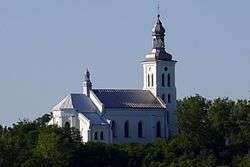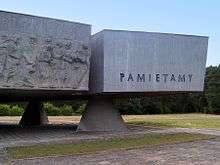Chełmno nad Nerem
Chełmno, often known by its full name Chełmno nad Nerem (pronounced [ˈxɛu̯mnɔ ˌnad ˈnɛrɛm]; meaning Chełmno on the Ner river) is a village in the administrative district of Gmina Dąbie, within Koło County, Greater Poland Voivodeship, in west-central Poland.[1] It lies approximately 19 km (12 mi) south-east of Koło and 135 km (84 mi) east of the regional capital Poznań. The village has a population of 350. It is the location of the Chełmno Extermination Camp Museum (pl) founded in 1994.[2]
Chełmno nad Nerem Kulmhof | |
|---|---|
Village | |
 Church of the Nativity of the Virgin Mary in Chełmno, where during World War II Jews were held overnight prior to their transfer to the old Chełmno castle, which served as extermination centre. | |
 Chełmno nad Nerem  Chełmno nad Nerem | |
| Coordinates: 52°6′49″N 18°44′55″E | |
| Country | |
| Voivodeship | |
| County | Koło |
| Gmina | Dąbie |
| Population | 350 |
The Holocaust Museum
The village, during World War II renamed as German: Kulmhof an der Nehr, is the historic site of the Chełmno extermination camp, operated in 1941–45 by Nazi Germany.

In 1987, the Holocaust Museum in Chełmno was established as branch of the District Museum in Konin. The site has been the subject of historical studies for decades, and a lot of preliminary work has already been done between 1961 and 1964; but also, serious mistakes were made at that time, for example, the remnants of the original gas van were not saved.[3]
In the 1980s aerial photography was used to map out the precise location of the mass graves, the barracks and the field crematorium. Further archeological studies were conducted, and the foundations of various camp structures were unearthed and preserved, including the Las rzuchowski (Rzuchowski forest) cemetery. They were followed by archival research and interviews with the locals. The construction of the actual museum began in 1988. It was inaugurated on June 17, 1990 along with the newly built Wall of Remembrance 37.5 meters (123 feet) long. The new memorials are still being added to the site. The camp museum is visited by around 50,000 guests annually.[3]
References
- "Central Statistical Office (GUS) - TERYT (National Register of Territorial Land Apportionment Journal)" (in Polish). 2008-06-01.
- "Chełmno Extermination Camp Museum (Muzeum byłego niemieckiego Obozu Zagłady Kulmhof w Chełmnie nad Nerem). Homepage". Archived from the original on 2016-10-30. Retrieved 2016-10-30.
- Zbigniew Pakuła. "Upamiętnienie ofiar". Były Obóz Zagłady w Chełmnie nad Nerem (in Polish). Biuro Muzeum w Chełmnie. pp. 1 of 5. Archived from the original on September 22, 2012. Retrieved October 31, 2012.

